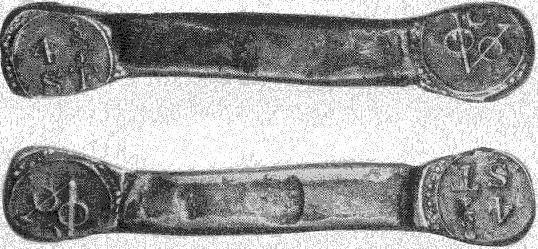

With respect to genuine 4 3/4 stuivers, in his book, p. 154, C. Scholten says, `it was decided by a Res. of Colombo dated Oct. 20, 1785 to strike Half copper Larins in the shape of small bars and declare them current at the rate of 4 3/4 Indian stivers. The length of these bars often differs considerably, e.g. 58, 70, 74, 85, 88 and 105 mm, weight 53.880, 60.200, 60.458 and 61.960 grams. The legal weight based on that of the stiver (see below) should have been 63.413 grams.
4 3/4 Stiver, or Half Larin. Flattened bar of Japanese copper, stamped at the ends on obv. and rev, with two round countermarks in which, to left, the Company's monogram with C above VOC and to right 4 3/4 ST within a rim of a dotted and a line circle.'
The ends of the obverse and reverse of the genuine piece are flattened, where the designs have been stamped, whereas those of the counterfeit are raised and the metal has not been disturbed by die-impressing the designs. The genuine piece shows normal tarnishing and corrosion, the corrosion products' being dark green in colour, whereas the counterfeit appears to have been heated to produce a thick film of black cupric oxide on its surface and then partially burnished to simulate tarnishing and corrosion, with patches of black oxide left deliberately around the details of the design.
Jacques Schulman, in a private communication sent after reading a
draft of this article, says:
`Astonishingly, we have seen many forgeries (all of them very modern,
with colours from light to very dark green, as well as nice chocolate
brown colours). So far we have found that the easiest way to detect
these forgeries is that the large 4 is cut in the modern way of
writing, whereas the old-fashioned way, as it is slightly shown on
your genuine piece, is more in the English way of writing the
4. Secondly, the company mark shows a rather oval-shaped `O' of which
the upper part passes over the bar of the `V' while the lower part
passes under the same bar; the `C' is usually inclined to fall over.'
Spectrographic analyses were carried out on both pieces to determine
their impurity contents; they are:
| Genuine | Counterfeit | |
| % | % | |
| Lead | *2.92 | <0.001 |
| Tin | 0.27 | <0.002 |
| Antimony | 0.12 | 0.001 |
| Bismuth | 0.004 | <0.001 |
| Nickel | 0.0 17 | <0.003 |
| Iron | 0.002 | 0.009 |
| Silver | 0.04 | 0.002 |
| Gold | 0.0002 | <0.0001 |
| Zinc | <0.01 | <0.01 |
| Total Impurities | 3.3832 | 0.0291 |
| Balance (copper) | 96.62 | 99.97 |
The analyses show, clearly, that the counterfeit has been made from high purity copper of a quality unavailable until very late in the 19th. century, thus confirming not only that it is a counterfeit but that it is also a modern or comparatively modern product.
The lead content of the genuine piece is much higher - by almost an order of magnitude (10 times) - than that (0.2-0.3%) of Swedish copper used for coin production in many countries of Europe, including England, a hundred years earlier. It would be interesting to know the reason for the high lead content of Japanese eopper of the period.
The few milligrammes of copper removed by scraping from both pieces for the spectrographic analyses left them virtually undamaged and the resultant bright areas were easily toned back to their original colour.
The Bureau would like to thank Mr. John Forbes, Deputy Warden of Goldsmiths' Hall, London, and his colleagues for carrying out the sampling and analyses.

|
| Genuine |

|
| Counterfeit |